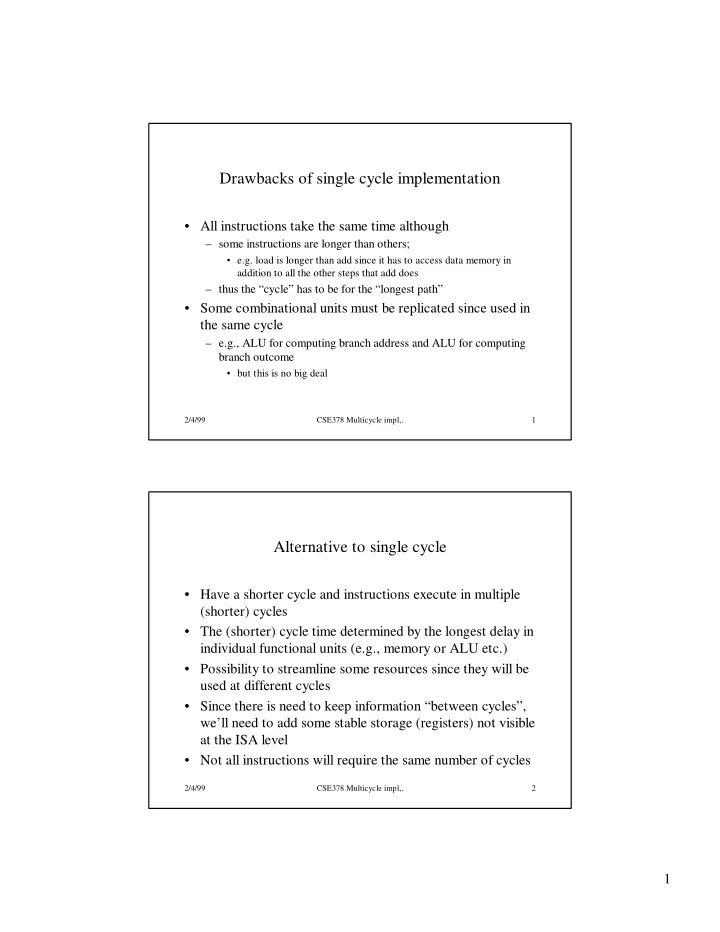

Drawbacks of single cycle implementation • All instructions take the same time although – some instructions are longer than others; • e.g. load is longer than add since it has to access data memory in addition to all the other steps that add does – thus the “cycle” has to be for the “longest path” • Some combinational units must be replicated since used in the same cycle – e.g., ALU for computing branch address and ALU for computing branch outcome • but this is no big deal 2/4/99 CSE378 Multicycle impl,. 1 Alternative to single cycle • Have a shorter cycle and instructions execute in multiple (shorter) cycles • The (shorter) cycle time determined by the longest delay in individual functional units (e.g., memory or ALU etc.) • Possibility to streamline some resources since they will be used at different cycles • Since there is need to keep information “between cycles”, we’ll need to add some stable storage (registers) not visible at the ISA level • Not all instructions will require the same number of cycles 2/4/99 CSE378 Multicycle impl,. 2 1
Multiple cycle implementation • Follows the decomposition of the steps for the execution of instructions – Cycle 1. Instruction fetch and increment PC – Cycle 2. Instruction decode and read source registers and branch address computation – Cycle 3. ALU execution or memory address calculation or set PC if branch successful – Cycle 4. Memory access (load/store) or write register (arith/log) – Cycle 5 Write register (load) • Note that branch takes 3 cycles, load takes 5 cycles, all others take 4 cycles 2/4/99 CSE378 Multicycle impl,. 3 Instruction fetch • Because fields in the instruction are needed at different cycles, the instruction has to be kept in stable storage, namely an Instruction Register (IR) • The register transfer level actions during this step IR ← Memory[PC] PC ← PC + 4 • Resources required – Memory (but no need to distinguish between instruction and data memories) – ALU to increment PC – IR 2/4/99 CSE378 Multicycle impl,. 4 2
Instruction decode and read source registers • Instruction decode: send opcode to control unit and…(see later) • Perform “optimistic” computations that are not harmful – Read rs and rt and store them in non-ISA visible registers A and B that will be used as input to ALU A ← REG[IR[25:21]] (read rs) B ← REG[IR[20:16]] (read rt) – Compute the branch address just in case we had a branch! ALUout ← PC +(sign-ext(IR[15:0]) *4 (again a non-ISA visible register ) • New resources – A, B, ALUout 2/4/99 CSE378 Multicycle impl,. 5 ALU execution • If instruction is R-type ALUout ← A op. B • If instruction is Immediate ALUout ← A op. sign-extend(IR[15:0]) • If instruction is Load/Store ALUout ← A + sign-extend(IR[15:0]) • If instruction is branch If (A=B) then PC ← ALUout (note this is the ALUout computed in the previous cycle) • No new resources 2/4/99 CSE378 Multicycle impl,. 6 3
Memory access or ALU completion • If Load MDR ← Memory[ALUout] (MDR is the Memory Data Register non-ISA visible register) • If Store Memory[ALUout] ← B • If arith Reg[IR[15:11]] ← ALUout • New resources – MDR 2/4/99 CSE378 Multicycle impl,. 7 Load completion • Write result register Reg[IR[20:16]] ← ALUout 2/4/99 CSE378 Multicycle impl,. 8 4
Streamlining of resources (cf. Figure 5.31) • No distinction between instruction and data memory • Only one ALU • But a few more muxes and registers (IR, MDR etc.) 2/4/99 CSE378 Multicycle impl,. 9 5
Recommend
More recommend